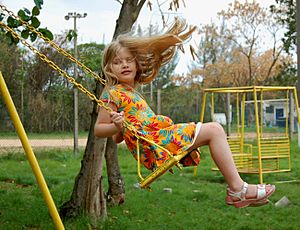Resonance facts for kids

In physics, resonance is a cool science idea where something starts shaking or vibrating more and more. This happens when it's pushed or nudged at just the right speed. Think about pushing someone on a swing. If you push at the right time, the swing goes higher and higher. That's resonance!
Every object has a special speed, or "frequency," where it loves to vibrate. This is called its resonant frequency. A vibrating object, like a guitar string, can have a main frequency and other related frequencies called harmonics.
An example of how resonance is useful is a guitar string. When you pluck it, it makes a special sound. The sound depends on how thick or tight the string is. This is because the string vibrates at its resonant frequency, creating the musical note.
On the other hand, resonance can sometimes be a problem. In earthquake engineering, for example, engineers try to make sure buildings won't shake too much if an earthquake happens. If a building's natural shaking speed matches the earthquake's shaking speed, it could cause a lot of damage.
Even in space, resonance plays a role! The Kirkwood gaps, which are empty spaces in the asteroid belt, are caused by something called orbital resonance. This is when the orbits of asteroids are affected by the gravity of larger planets like Jupiter, making them avoid certain paths.
Contents
What is Resonance?
Resonance happens when an object is made to vibrate at its own natural speed. Imagine you have a toy car on a spring. If you push it gently at just the right time, it will bounce higher and higher. If you push it too fast or too slow, it won't bounce as much. That "just right time" is its resonant frequency.
How do things Resonate?
When you apply a small, repeated force to an object at its resonant frequency, the energy from each push builds up. This makes the object vibrate with bigger and bigger movements, or "amplitudes." It's like adding small amounts of energy at the perfect moment, causing a huge effect.
Examples of Resonance in Daily Life
Resonance is all around us, even if we don't always notice it!
Musical Instruments
- Guitar Strings: When you pluck a guitar string, it vibrates at its resonant frequency, creating a specific musical note. The sound then gets louder because the guitar's body also resonates with the string's vibrations.
- Wind Instruments: In a flute or trumpet, the air inside the instrument vibrates at certain resonant frequencies, producing different musical notes.
Radio and TV
Your radio or TV uses resonance to pick up signals. When you tune to a specific station, you're adjusting the radio's electronic circuits to resonate with the frequency of that station's broadcast signal. This allows your device to "hear" only that station.
Microwave Ovens
Microwave ovens use resonance to heat food. They produce microwaves at a frequency that makes water molecules inside your food vibrate very fast. This vibration creates heat, cooking your meal.
When Resonance Can Be a Problem
While resonance is often useful, it can also cause issues if not managed carefully.
Buildings and Earthquakes
Engineers who design buildings need to be very careful about resonance. If an earthquake's shaking frequency matches a building's natural resonant frequency, the building could shake violently and be damaged. This is why modern buildings often have special features, like seismic dampers, to absorb vibrations and prevent dangerous resonance.
Bridges
In the past, some bridges have collapsed due to resonance caused by strong winds. The wind created forces that matched the bridge's resonant frequency, causing it to sway more and more until it broke apart. Today, engineers design bridges to avoid this problem.
Related pages
Images for kids
-
Increase of amplitude as damping decreases and frequency approaches resonant frequency of a driven damped simple harmonic oscillator.
-
A standing wave (in black), created when two waves moving from left and right meet and superimpose
-
Standing waves in a string – the fundamental mode and the first 5 harmonics.
-
Animation illustrating electrical resonance in a tuned circuit, consisting of a capacitor (C) and an inductor (L) connected together. Charge flows back and forth between the capacitor plates through the inductor. Energy oscillates back and forth between the capacitor's electric field (E) and the inductor's magnetic field (B).
See also
 In Spanish: Resonancia para niños
In Spanish: Resonancia para niños








